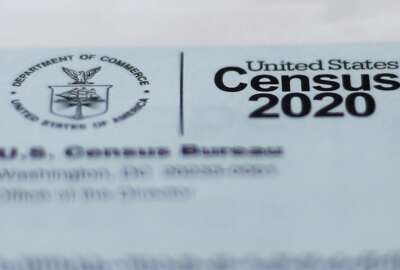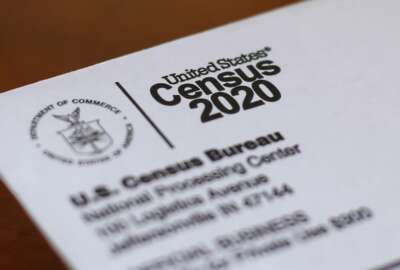
2020 Census workers begin knocking on doors in 3-phased ‘soft launch’
The Census Bureau postponed field operations and suspended hiring several times during the course of the pandemic. Those delays led the Trump administration to ask...
Best listening experience is on Chrome, Firefox or Safari. Subscribe to Federal Drive’s daily audio interviews on Apple Podcasts or PodcastOne.
The decennial census, the country’s largest peacetime mobilization, has gone through more than a few challenges during the coronavirus pandemic.
The Census Bureau postponed field operations and suspended hiring several times during the course of the pandemic. Those delays led the Trump administration to ask Congress to postpone deadlines to submit apportionment and redistricting data.
Despite these setbacks, officials told reporters in a call Wednesday that the bureau has begun a “soft launch” of its non-response follow-up. While these efforts will begin nationwide Aug. 11, the phased approach will allow enumerators to knock on doors in cities and states where cases of COVID-19 have trended downward.
The bureau began its soft launch of non-response follow-up on Monday, sending 10,000 enumerators out to areas that include New Orleans, Oklahoma City and Kansas City, Missouri.
The second wave of enumerators will begin knocking on doors July 23 in the following areas:
- Crystal City, Virginia,
- Hartford, Connecticut,
- State College Pennsylvania,
- Evansville, Indiana,
- Wichita, Kansas,
- Tacoma, Washington
A third wave of enumerators from 40 area census offices will begin knocking on doors July 30.
Enumerators will interview less than 40% of households in the United States that did not yet mail back a 2020 Census questionnaire, or complete it over the phone or online.
Nearly 62% of households have filled out the 2020 Census — exceeding the bureau’s goal of 60.5% — and about 80% of responses were completed online.
While internet self-response is a new feature for the 2020 Count, Al Fontenot, the associate director for decennial programs, said the internet self-response platform didn’t experience “a single minute” of downtime.
During performance and scalability testing last year, the bureau set up the platform able to withstand a level of concurrent users well beyond what the bureau expected.
Fontenot said the bureau saw a maximum of about 90,000 concurrent users on the self-response platform, even though bureau officials prepared the systems to be able to handle as many as 600,000 concurrent users.
While the pandemic hasn’t limited the bureau’s ability to recruit temporary workers, about a third of applicants are old enough to be considered high-risk for COVID-19 by the Centers for Disease Control and Prevention.
However, Associate Director for Field Operations Tim Olson said the bureau has not seen “any substantial decline” in hiring.
“We are very aware that with the coronavirus pandemic, some applicants may no longer be interested, and there may be locations where this is more pronounced,” he said.
Read more: Workforce News
The bureau has offered jobs to more than 900,000 applicants, but based on prior censuses, many of those applicants will drop out as they go through the vetting and hiring process. A majority have gone through fingerprinting, while 500,000 have completed their background checks.
“If we were to hire them today, they would be ready to onboard as an employee,” Olson said about the latter group of applicants.
The bureau no longer actively recruits for more applicants, but Olson said it has 3 million applicants available for consideration and receives about 1,500 new applications every day on its online job portal.
The bureau expects to hire as many as 500,000 enumerators, and is urging applicants to complete the fingerprinting and background checks in time for training that begins nationwide July 31.
Given pandemic conditions, Olson said enumerators will follow social distancing practices when knocking on doors.
“They would knock, they would ring a doorbell, and then they would maintain the minimum six-foot social distancing in the interaction with the person,” Olson said.
While the bureau in previous counts never explicitly prevented enumerators from entering someone’s residence when conducting a census interview, Olson said the bureau has now prohibited its temporary workers from doing so.
Read more: Management News
The bureau has also stocked up on personal protective equipment kits for enumerators, having purchased more than 2 million masks, 14 million gloves and a million disinfecting wipes, as well as 48,000 gallons of hand sanitizer.
Under normal conditions, the bureau allows 12 weeks to complete non-response follow-up across the country, but under the pandemic, enumerators will complete that work in six-to-seven weeks.
“That gives us an incredible amount of flexibility — that if there are areas, geographies where we cannot begin, as our plan is, on Aug. 11, we could then open them up a little bit later,” Olson said.
Area census offices that complete their work before fieldwork ends on Oct. 31 could also send their enumerators to help nearby areas that have not yet been completed.
However, Fontenot said route optimization technology will allow enumerators to complete their work more efficiently.
“This is not a sequential address operation, they are going to where people haven’t responded. The system is able to take their time availability, data that we have on when people are most likely to be at home, and then schedule them to make their calls during that timeframe,” Fontenot said. “That is one of the operations that in every one of our tests is proven to be indispensable in terms of making our operation more efficient and more effective.”
Olson said the bureau will launch a “final-push campaign” next week that reminds households to self-respond before enumerators begin going door-to-door nationwide in August.
While Congress appears willing to push back statutory deadlines for the bureau to deliver redistricting and apportionment data, bureau officials urged lawmakers to see that provision make it through the fiscal 2021 spending bill.
Read more: Census News
Fontenot said that lawmakers and committee staffers have understood the need to extend those deadlines to ensure a complete and accurate 2020 count. However, if Congress didn’t approve the extension, he said the bureau is “past the window of being able to get those counts” by the Dec. 31 deadline.
While 2020 field operations are moving ahead, the creation of two new political jobs at the bureau has raised questions from the Commerce Department’s inspector general.
The watchdog office on Tuesday asked the bureau for position descriptions and resumes for Nathaniel Cogley, the bureau’s new deputy director for policy, and his senior adviser, Adam Korzeniewski.
The IG has also asked how much each position pays, and whether the bureau has any justification for creating these political jobs.
Census Bureau Director Steven Dillingham announced these hires last month, and said they would “help the Census Bureau achieve a complete and accurate 2020 Census and study future improvements.”
Michael Cook, the head of the bureau’s Public Information Office, told reporters the bureau has received the letter and will respond to the inquiry.
Copyright © 2025 Federal News Network. All rights reserved. This website is not intended for users located within the European Economic Area.
Jory Heckman is a reporter at Federal News Network covering U.S. Postal Service, IRS, big data and technology issues.
Follow @jheckmanWFED





